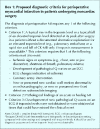Surveillance and prevention of major perioperative ischemic cardiac events in patients undergoing noncardiac surgery: a review
- PMID: 16186585
- PMCID: PMC1216320
- DOI: 10.1503/cmaj.050316
Surveillance and prevention of major perioperative ischemic cardiac events in patients undergoing noncardiac surgery: a review
Abstract
This is the second of 2 articles evaluating cardiac events in patients undergoing noncardiac surgery. Unrecognized myocardial infarctions (MIs) are common, and up to 50% of perioperative MIs may go unrecognized if physicians rely only on clinical signs or symptoms. In this article, we summarize the evidence regarding monitoring strategies for perioperative MI in patients undergoing noncardiac surgery. Perioperative troponin measurements and 12-lead electrocardiograms can detect clinically silent MIs and provide independent prognostic information. Currently, there are no standard diagnostic criteria for perioperative MIs in patients undergoing noncardiac surgery. We propose diagnostic criteria that reflect the unique features of perioperative MIs. Finally, we review the evidence for perioperative prophylactic cardiac interventions. There is encouraging evidence that some perioperative interventions (e.g., beta-blockers, alpha2-adrenergic agonists, statins) may prevent major cardiac ischemic events, but firm conclusions await the results of large definitive trials. The best evidence does not support a management strategy of preoperative coronary revascularization before noncardiac surgery.
References
-
- Devereaux PJ, Goldman L, Cook DJ, Gilbert K, Leslie K, Guyatt GH. Perioperative cardiac events in patients undergoing noncardiac surgery: a review of the magnitude of the problem, the pathophysiology of the events and methods to estimate and communicate risk [review]. CMAJ 2005;173(6):627-34. - PMC - PubMed
-
- Driscoll AC, Hobika JH, Etsten BE, Proger S. Clinically unrecognized myocardial infarction following surgery. N Engl J Med 1961;264:633-9. - PubMed
-
- Rosenman RH, Friedman M, Jenkins CD, Straus R, Wurm M, Kositchek R. Clinically unrecognized myocardial infarction in the Western Collaborative Group Study. Am J Cardiol 1967;19:776-82. - PubMed
-
- Medalie JH, Goldbourt U. Unrecognized myocardial infarction: five-year incidence, mortality, and risk factors. Ann Intern Med 1976;84:526-31. - PubMed
-
- Grimm RH Jr, Tillinghast S, Daniels K, Neaton JD, Mascioli S, Crow R, et al. Unrecognized myocardial infarction: experience in the Multiple Risk Factor Intervention Trial (MRFIT). Circulation 1987;75:II6-8. - PubMed
Publication types
MeSH terms
LinkOut - more resources
Full Text Sources
Other Literature Sources
Medical


